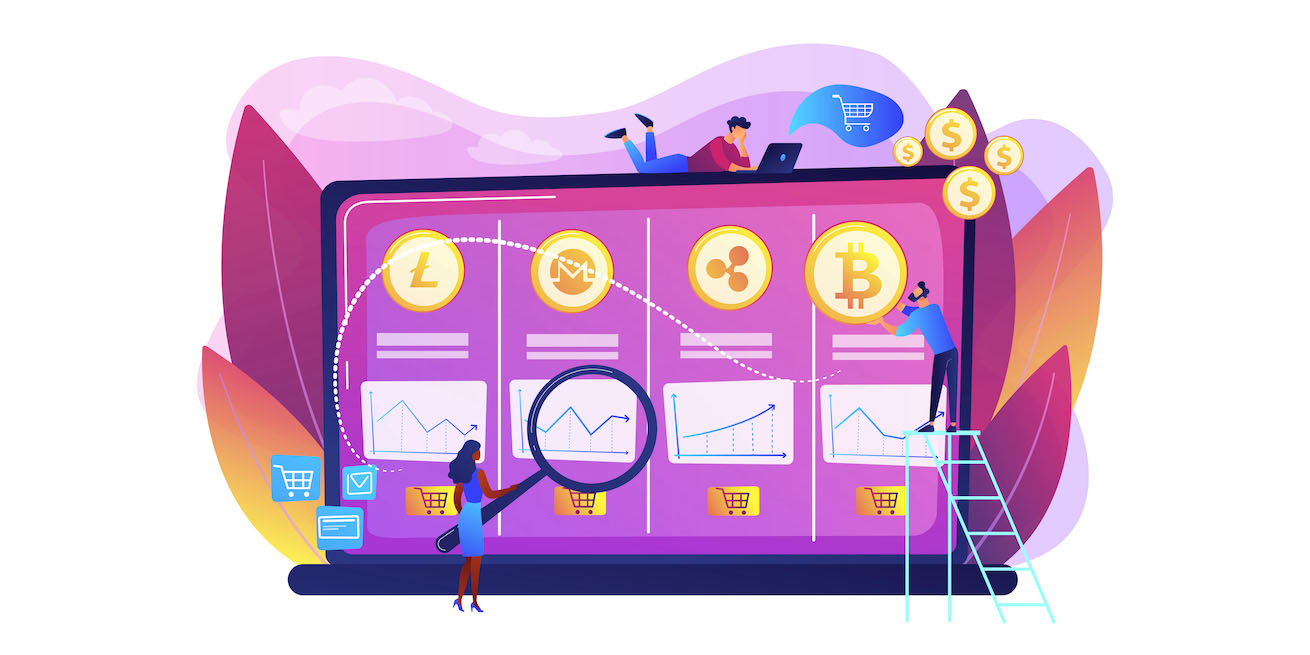E-commerce is a new science. And the most interesting part of this is that there are researchers from both sides of the marketing funnel.
Customers from youth to tech-savvy retirees use various devices to find the products and services they need and explore things they like.
All sorts of e-commerce marketing specialists research methods of business expansion, which emerge faster than organic food stores can pop up in your hometown.
The brightest e-commerce marketing researchers invent new trends and move the industry forward.
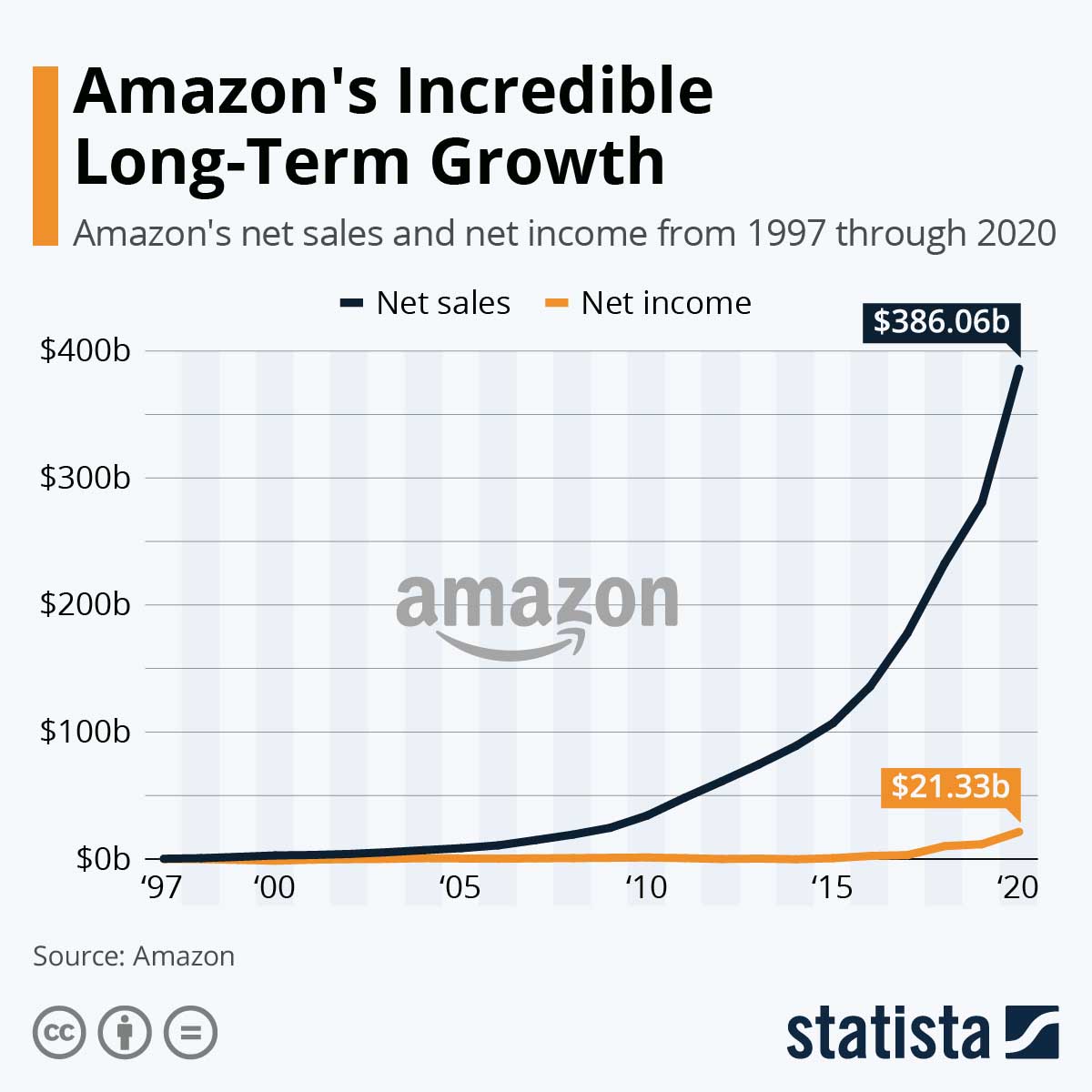
For Jeff Bezos, who worked hard for more than twenty years and became the world’s wealthiest person, Amazon’s becoming a $1.7 trillion company was the culmination of his invention.
7 E-commerce Marketing Recommendations from Jeff Bezos
Before we highlight things that are crucial for building a profitable e-commerce business that’s capable of finding its own way to expand, we’d like to emphasize the things that made Jeff Bezos one of the most successful entrepreneurs of the century.
Below are insights from Jeff Bezos that will serve not only as e-commerce marketing ideas for newcomers but as reminders for case-hardened business owners looking for new ways to scale.
1. Be passionate about your business
Having passions is a fantastic gift. You don’t have to choose your passions, because they pick you. But you have to be alert to them. When you find your passion, it gives you direction and purpose. Sometimes, we let our intellectual selves overrule our passions. That’s what you need to guard against.
2. Experiment and embrace failure
It’s incredibly hard for people to make bull bets. And if you’re going to take bull bets, they’re going to be experiments. If there are experiments, you don’t know ahead of time whether they’re going to work.
Experiments by their very nature are prone to failure. But big successes compensate for dozens and dozens of things that don’t work. Amazon has seen billions of dollars of failures. None of them are fun, but they don’t matter.
What matters is companies that don’t experiment and embrace failure eventually get in the desperate position where the only thing they can do is kind of a Hail Mary bet at the very end of their corporate existence, whereas companies are making bets all along, even big bets, but not company bets. That’s when you’re desperate and that’s the last thing you could do.
3. Find work–life harmony and lean into the future
You can be out of work and have a terrible work–time balance even though you’ve got all the time in the world. You could feel miserable and be draining energy. You have to find that harmony. For most people, it’s about meaning. People want to know they’re doing something interesting and useful.
For Amazon, because of the challenges we have chosen for ourselves, we get to work in the future, and it’s super fun to work in the future for the right kind of person.
You need to be nimble and robust, so you need to be able to take a punch and you also need to be quick, innovative, and do new things at a high speed. That’s the best defence against the future, and you have to always be leaning into the future. If you’re leaning away from it, the future is going to win every time. Never ever ever lean away from the future.
4. Be proud not of your gifts but of your hard work and choices
We all have adversity in our lives. I doubt you know anybody who has not experienced adversity. And that’s good, because that’s what teaches us to get back up, fall down, and get back up. It always happens. You get certain gifts in life and you want to take advantage of those. My advice on adversity and success would be to be proud not of your gifts but of your hard work and your choices.
You might be really good at math, but practicing that math takes it to the next step. That could be very challenging, hard, and take a lot of sweat. That’s a choice. You can’t be really proud of your gifts, because they were given to you. You can be grateful and thankful for them, but you choose to work hard and do hard things. Those are choices you can be proud of.
5. Become a domain expert to invent, but don’t get trapped
You have to be a domain expert; you have to learn enough. But the danger is that once you become a domain expert, you can be trapped by that knowledge. So inventors have this paradoxical ability to have that 10,000 hours of practice and be a real domain expert while still having that beginner’s mind and looking at it freshly even though they know so much about the domain. That’s the key to inventing — you have to have both. I think all of us have all that inside of us, and we can all do it. But you have to be intentional about it.
6. There are no shortcuts
It’s easy to come up with new ideas. But it’s very hard to turn an idea into a successful product. There are too many steps in between. Taking an idea successfully all the way to the market and turning it into a real product that people care about and that really improves people’s lives is a lot of hard work.
Entrepreneurs have to be persistent, know when to bewitch, and have a combination of stubborn relentlessness and flexibility. You need to be stubborn because otherwise it’ll be too easy to give up, and you need to be very flexible on the details because as you go along pursuing your vision, you’ll find that some of your preconceptions were wrong and you’re going to need to change things.
7. Don’t chase the hot passion of the day, and be clear with yourself
You see this all over the place in many different contexts. For example, the internet mania in 1999 was almost like the 1849 gold rush.
If you go back to the history of the gold rush, you’ll find that everybody who was in shouting distance of California at the time quit their jobs and started panning for gold. That almost never works. And even if it does work according to some metric of financial success or whatever it might be, it leaves you ultimately unsatisfied.
You need to be very clear with yourself, and the best way to do that is by projecting yourself forward to age 80, looking back on your life, and trying to make sure that you’ve minimized the number of regrets you have. That works for career and family decisions.
Always take a long point of view. There are a lot of paths of satisfaction, and you need to find the one that works for you.
To understand which path is right for you and your business, we should begin with a definition: What is e-commerce marketing?
What Is E-commerce Marketing?
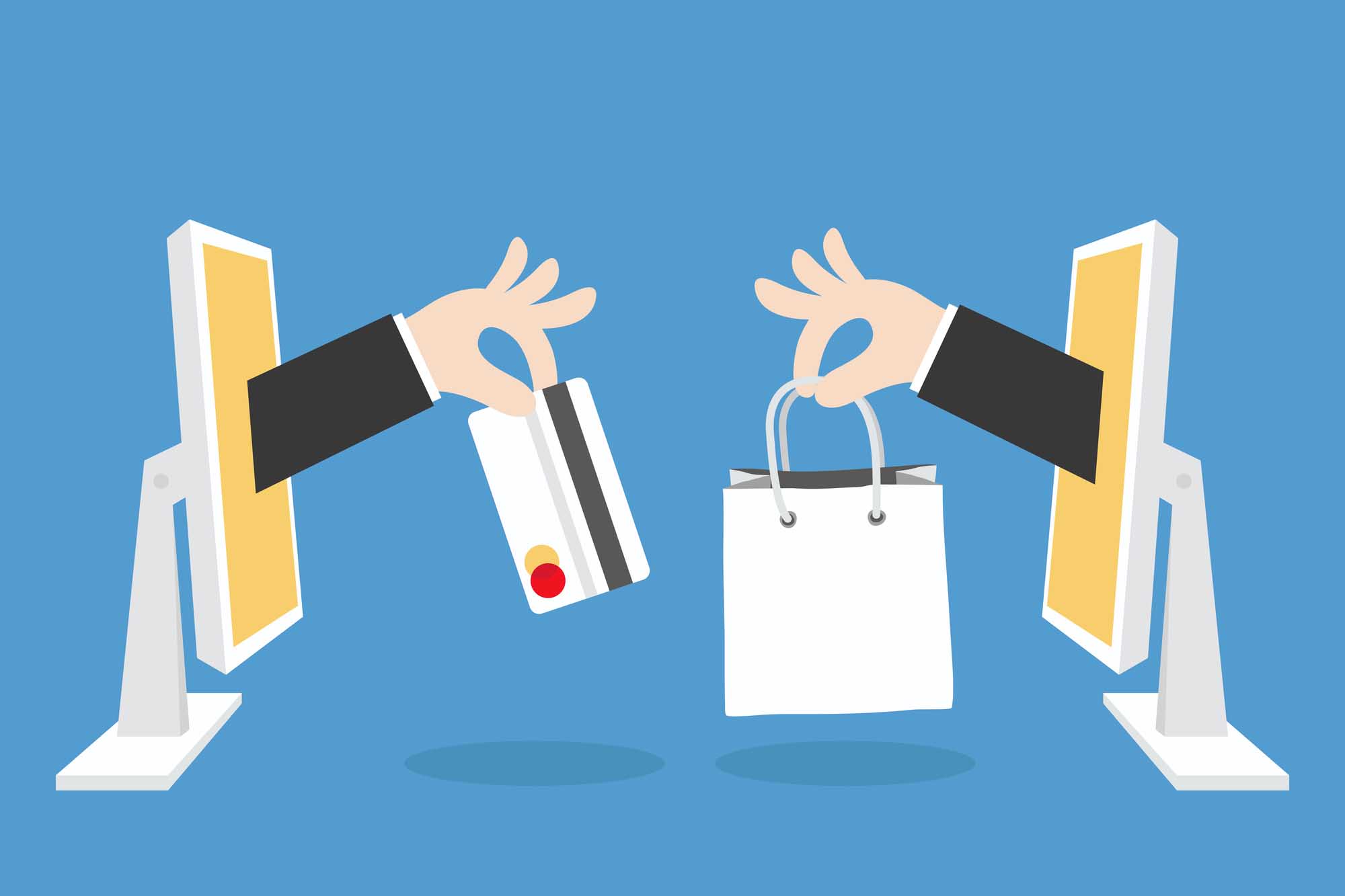
E-commerce marketing is advertising and selling products and services online by awakening the interest of potential customers or leads in a business or brand, converting them into permanent shoppers, and maintaining their loyalty using multiple techniques and channels.
The Major E-commerce Marketing Channels and Why You Should Use Them
E-commerce digital marketing is amazing because of its accessibility and diversity. It’s never been easier to start a business. The same goes for promoting a business.
Traditional sophisticated and overpriced means of offline advertising have taken a backseat to more accessible and cheaper means of online advertising.
This is especially visible in terms of the change in marketing spending.
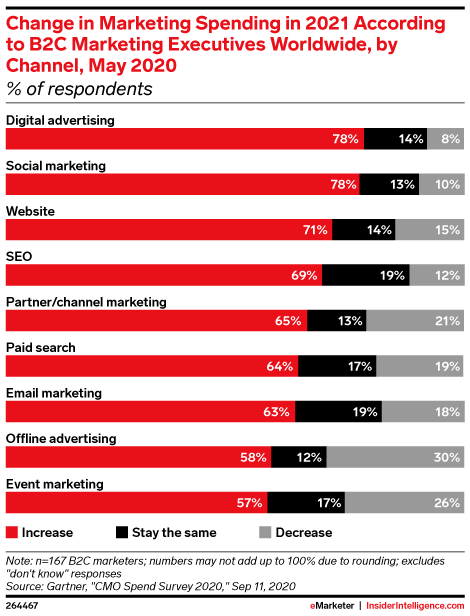
According to eMarketer, marketing executives all around the world spend much more on digital ads, social media promotions, search engine optimization (SEO), and affiliate marketing and far less on offline advertising and event marketing than they did before.
What channels should you use for your e-commerce marketing strategy and what should this strategy be? We’ll begin with the basics and continue with some marketing recommendations that will be relevant for years to come.
Optimize Your Business for Google and Other Search Engines
Search engine optimization. In e-commerce and other digital spheres, we call this SEO.
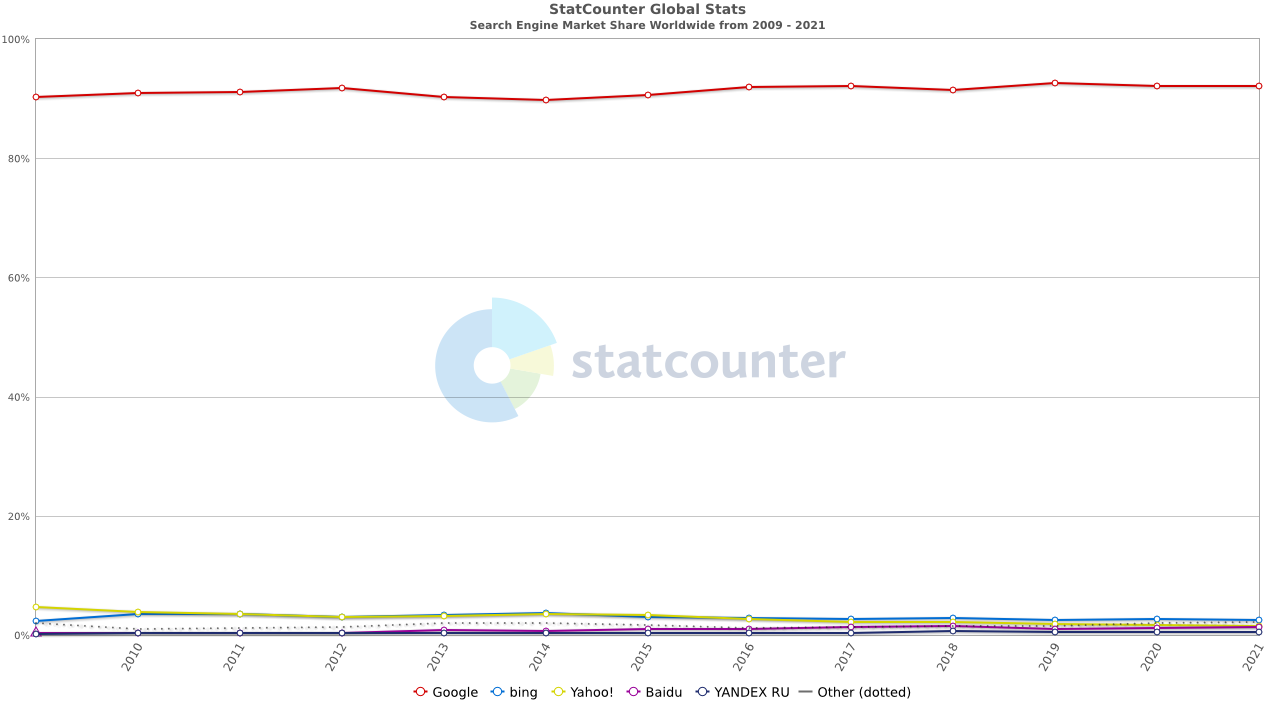
In reality, you should optimize your website for Google because all optimization standards have been established and regulated by Google. Not to mention that Google holds over 92% of the global search engine market share.
The better you optimize your website, the more popular it gets on search engines. And the more popular it gets on search engines, the more profitable your e-commerce business becomes.
An e-commerce business that doesn’t have an SEO-friendly website has no room to grow. Period.
One more crucial thing to realize about SEO is that it’s an ongoing process. After you optimize your website for search engines, you need to watch over your website rankings and keep up with updates to the Google search algorithm and ranking system.
And if you learn e-commerce marketing by reading articles like this one, you should also learn about SEO. Though most popular e-commerce platforms already include all the necessary functionality to appear on Google search result pages and provide SEO support, every e-commerce specialist should be aware of SEO fundamentals in order to understand how Google search works and how one can use it to promote an online business.
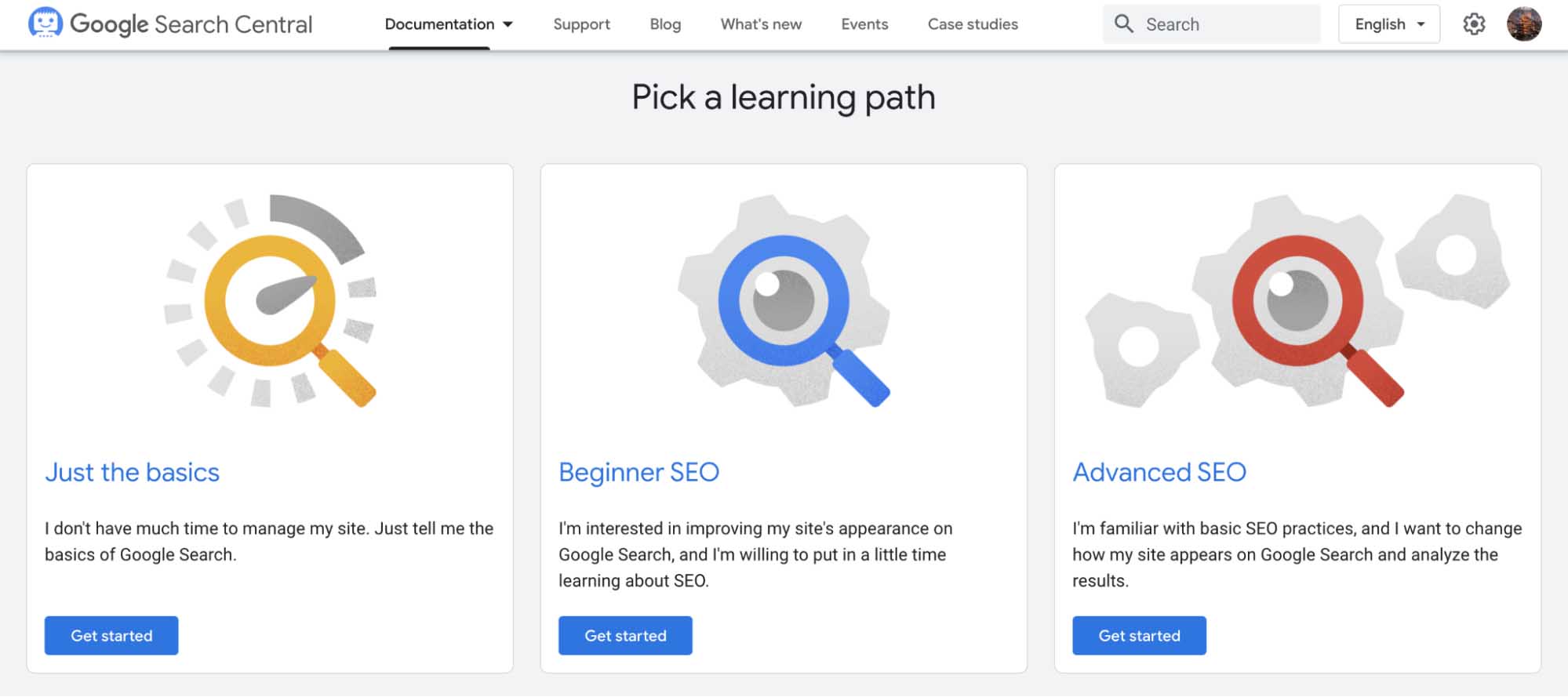
If you’re looking for a guide, visit Google Search Central, where you can choose the learning path that corresponds to your level of SEO expertise.
Launch Advertising Campaigns with Google Ads
One more thing to mention about Google is that it’s the world’s largest advertising network.
Along with growing the positions of your e-commerce business on Google results pages with SEO, you can use e-commerce marketing services in Google Ads.
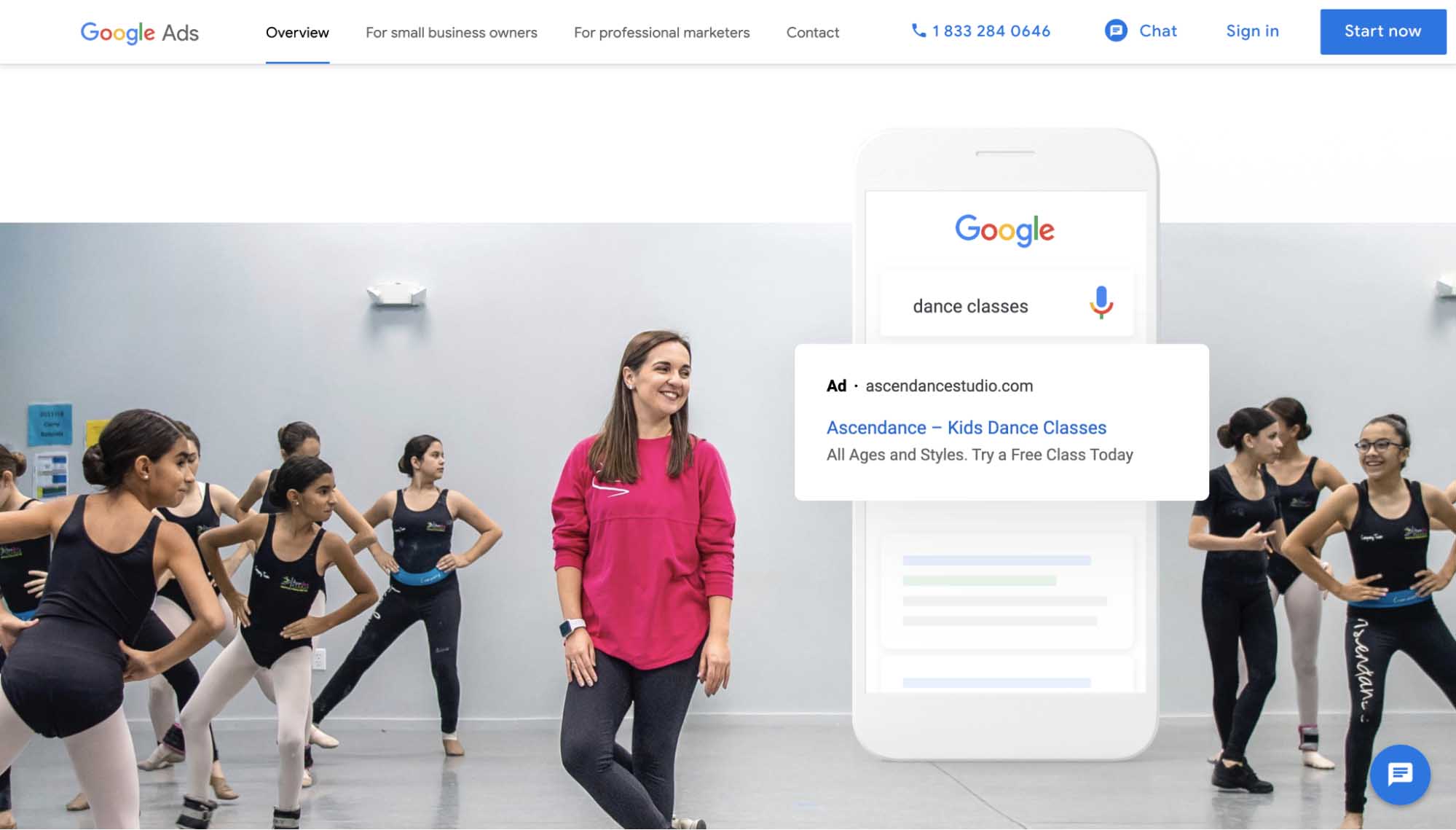
Google Ads is the advertising platform that allows your e-commerce business to find the right customers by showing them relevant ads in the right places.
There are seven major types of ad campaigns in Google Ads:
- Search campaigns. Create text ads and target specific people based on their Google search inquiries.
- Display campaigns. Create image ads and demonstrate them on millions of websites and apps across the web.
- Video campaigns. Make video ads and show them in different places on YouTube.
- Shopping campaigns. Promote products on Google search result pages and Google’s shopping tab with ads that contain product images and prices.
- App campaigns. Find new customers and increase online store sales within your mobile app by running ads across Google search results, Google Play, YouTube, and millions other websites and apps.
- Local campaigns. Drive customers to physical stores with automatically optimized ads shown across Google search results, Google Maps, YouTube, and millions of other websites and apps.
- Smart campaigns. Create ads and let Google choose targeting preferences based on your business information and budget.
After you launch your ad campaigns in Google Ads, you can monitor their performance in real time and optimize ad creatives and settings if necessary.
Segment and Automate Your Email Marketing
When people sign up with an online shop, they leave their email address. By definition, this makes e-commerce email marketing one of the most powerful channels your business can use to promote itself and boost sales.
Another huge advantage of e-commerce email marketing is that you can collect email addresses from plenty of other marketing channels. With just enough customer email addresses, you can segment your customers into groups.
In such a way, your e-commerce business can:
- get a better understanding of customers’ interests and needs and interact with customers more effectively
- personalize promotional emails and increase the conversion rate
Email segmentation goes hand in hand with email automation, which has two major purposes.
The first purpose is to help e-commerce marketers optimize communication and buying processes by scheduling all email marketing activity and sending recurring emails such as registration confirmation emails or abandoned cart emails.
The second purpose is to help e-commerce marketers focus on producing high-quality, relevant, and appealing email headlines and texts to increase email marketing benchmarks: open rate, click rate, bounce rate, and conversion rate.
Thanks to a bunch of user-friendly email marketing platforms that make it possible for companies to integrate automation into their marketing strategies, there are a few e-commerce marketing mistakes in email automation that you can easily avoid, such as wrong scheduling and underestimating spam filtering.
Join the Facebook Family to Sell Directly on Social Media
Social media is a really vital thing, isn’t it?
Most people can’t spend an hour without checking their social media profiles.
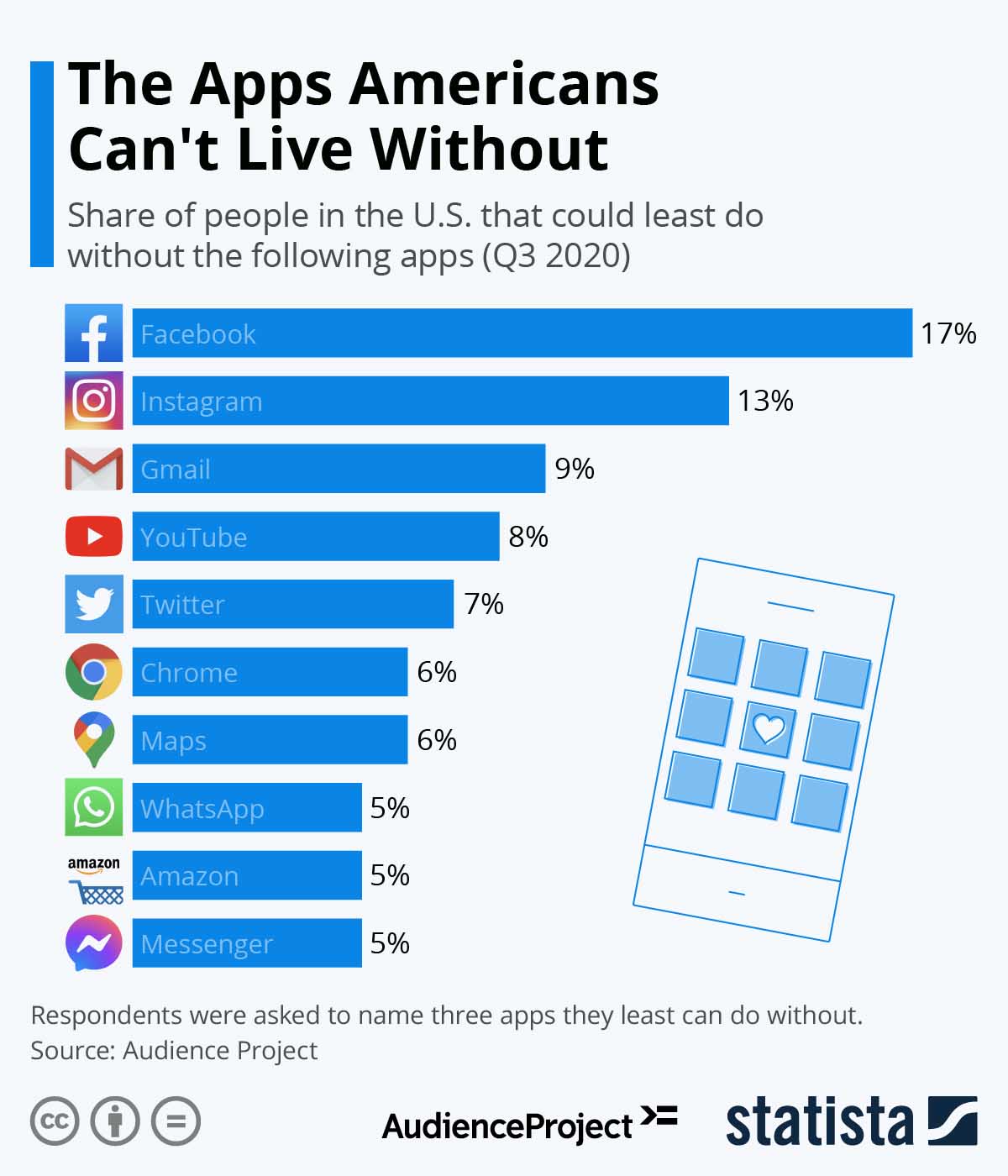
According to a survey conducted by Audience Project, four of the ten most beloved mobile apps in the United States — Facebook, Instagram, YouTube, and Twitter — are social media apps.
For e-commerce, social media is essential not even because it gives plenty of advertising opportunities but because of the ability to sell products immediately without driving customers to an e-shop. David Beisel invented the term social commerce in 2005 to refer to this.
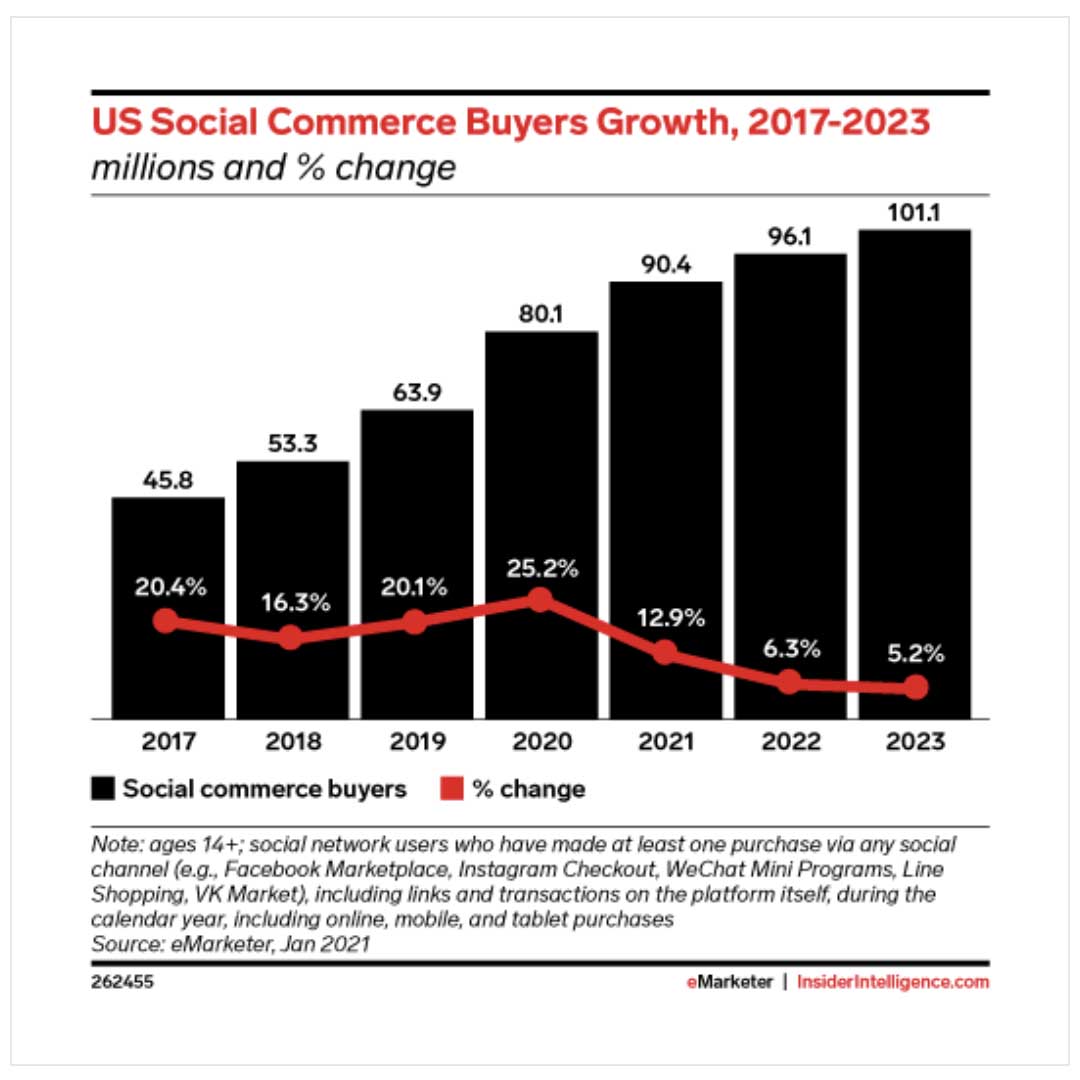
According to the Social Commerce 2021 e-commerce marketing report by eMarketer, the number of social media shoppers in the United States has increased from 45.8 million in 2017 to 80.1 million in 2020 and is projected to reach 101.4 million by 2023.
To reap the benefits of social commerce, your e-commerce company should join the Facebook family of apps and services that comprises all products owned by Facebook, Inc.
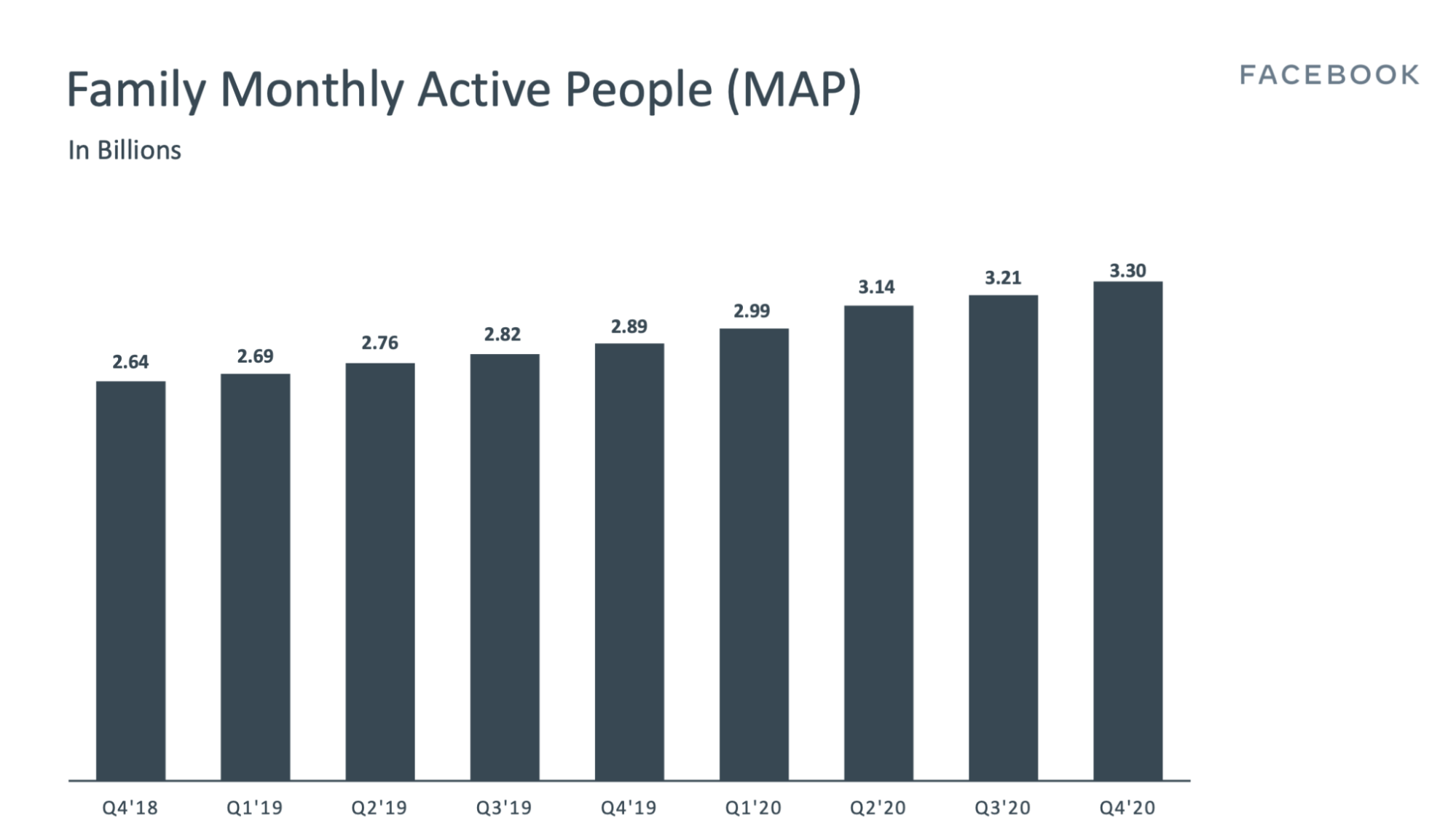
According to the Facebook Q4 2020 Earnings presentation, more than 3.3 billion people visit at least one of the Facebook family products — Facebook, Instagram, WhatsApp, and Messenger — every month.
So far, you can sell products only on Facebook and Instagram. However, it’s very important for your company to be present on each Facebook family platform. Thanks to the united environment, you get a number of huge advantages. Let’s summarize them below.
Cover all possible audiences and find the right platform. Though most users have profiles on both Facebook and Instagram, some prefer one platform over the other. After you create business accounts on both platforms, you’ll be able to promote your e-store using different content plans for different audiences or test the platforms and find the one you benefit from most.
Communicate with customers across all platforms. Given the rapid rhythm of life, it’s important to respond as quickly as possible. The ecosystem of Facebook apps allows businesses to combine Facebook, WhatsApp, Messenger, and Instagram in order to chat with customers and answer their messages in one place.
Optimize ad delivery. If you’re planning to launch paid ads on at least one of the Facebook family platforms, Facebook Ads Manager will help you create very effective e-commerce marketing strategies by correctly setting all the parameters: marketing objectives, budgets, audiences, and more. Not to mention that Facebook uses machine learning to improve ad delivery based on a business’s needs.
Produce Original Content for an E-Commerce Blog
We’re living through the golden age of content marketing. Everyone with a smartphone in hand and an active social media profile is either a content creator or a content consumer.
As one of the most popular means of sharing content, blogging has become a job that can bring good money. That’s why bloggers are in every corner of the planet, and that’s why you need a blog for your e-commerce business.
While social media platforms are the vertebrae of e-commerce content marketing, blogs are the backbone. Google loves original content that brings real value. Posting such content on a blog is the best way to attract that love and boost your e-store’s rankings.
There are several amazing advantages that blogging brings for an e-commerce company:
- Free traffic. Write high-quality articles that include relevant and useful information based on preliminary SEO research. Invite authors and bloggers to publish third-party content on your blog.
- More conversions. Promote your products and services with no boundaries and using any form of written, visual, and audio content.
- Stronger community. Inform customers about new things related to your e-commerce business. It can be anything you wish: products, services, company updates, events, e-commerce features, and beyond.
Which types of content should you post on your e-commerce blog?
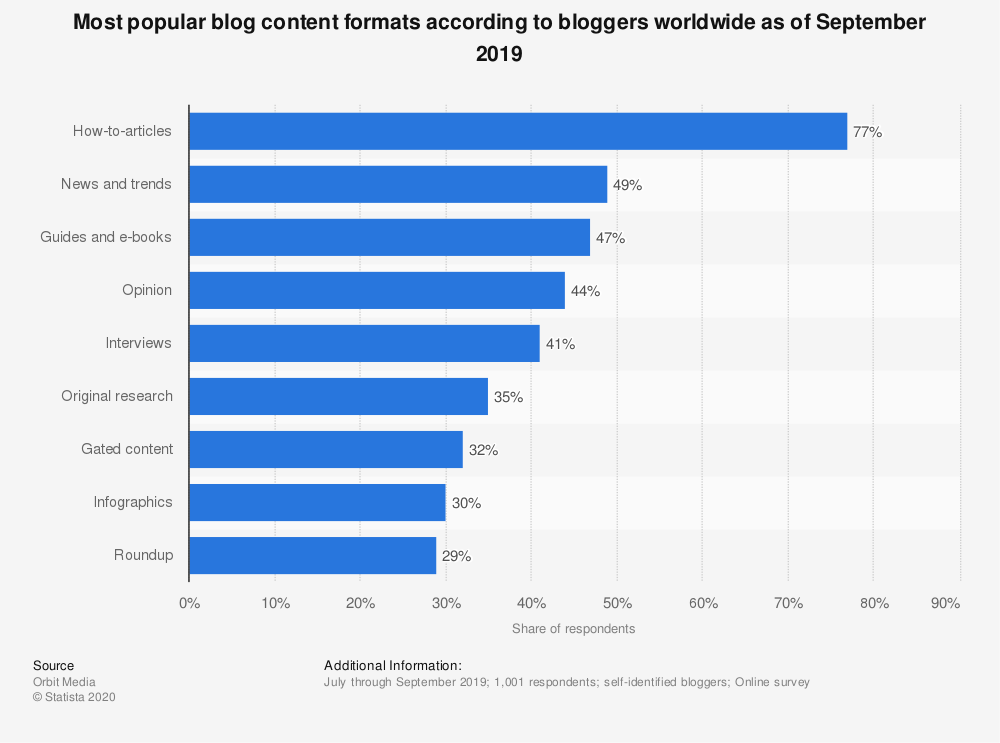
According to the 2019 Annual Blogger Survey conducted by Orbit Media, 77% of bloggers all around the world consider how-to articles to be the most popular form of blog content, followed by news and trends, guides and e-books, opinions, interviews, original research, gated content, infographics, and roundups.
What topics should you use to create content that helps your business expand?
To find the best content niches, you should conduct:
- Competitor research. Determine the closest competitors, visit their blogs, and analyze the content they post according to its popularity and relevance.
- SEO research. Learn the connection between SEO and blogging in general. In particular, prepare topic-related keyword semantics for every post and article you plan to publish.
- Brand research. Just lay back and think about your e-commerce business from the expansion perspective.
Last but not least, remember that getting profits by means of blogging is a long-term adventure. Still, a lot of patience and diligence will be more than compensated.
Advertise on Video Platforms That Are Popular among Your Customers
Just like it did during the spread of television in the mid 1950s, video today is going through a renaissance.
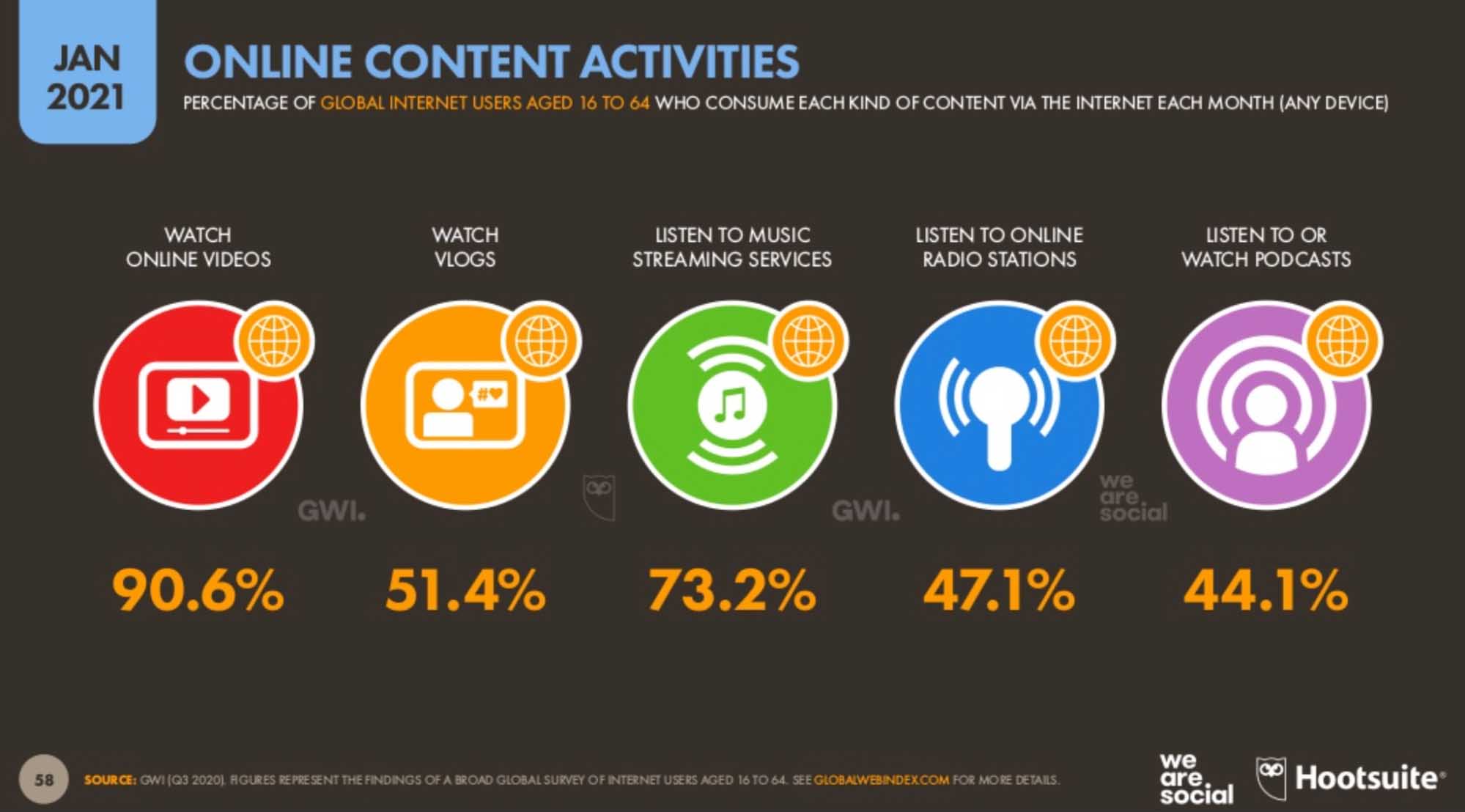
According to the Global State of Digital Report 2021 by Hootsuite, nearly 91% of people watch online videos, which is the most popular type of online content so far. Besides that, almost 52% of people watch vlogs and over 44% of people watch podcasts.
This is changing the game in terms of how to market e-commerce businesses, demonstrate products and services online, and emphasize their advantages and disadvantages.
Aside from publishing video content on product pages or other spaces of your online store, you should advertise on major video platforms.
But before that, you need to figure out two things:
- The platforms your target audience loves most. There are plenty of video platforms such as YouTube, TikTok, Instagram, Facebook, and Snapchat. If your business goal is massive expansion, the best thing to do is use them all. If you want to focus on your local market and a narrow audience, picking the ones your customers use most may be a better option.
- Content that trends on these platforms. Posting the same videos on different platforms isn’t exactly the right thing to do. If you want to benefit from platforms the most, you’ll need to find out why people watch videos on different platforms and which types of video content prevail on them. For example, if you decide to do YouTube e-commerce marketing, it’s great to make longer how-to videos, while TikTok is a platform aimed at promoting a brand with entertaining videos that last just seconds.
NOTE: Make any kind of professional video content for e-commerce in minutes with Softcube AI.
4 E-commerce Practices to Improve the Customer Experience
Building a great customer experience is a crucial part of any e-commerce marketing plan. Here are a few recommendations that will help you improve the ways customers engage with your business online.
Think Through the User Interface (UI) to Perfect the User Experience (UX)
When customers arrive at your e-commerce website, you want them to feel at home. They should be able to easily and quickly navigate the interface and complete their shopping without any barriers.
The user interface (UI) and the user experience (UX) are two closely related components that improve the customer experience with a website. The UI is what users interact with when they arrive at a website. The UX is about what users feel when they interact with the UI.
Find a UI/UX designer who understands the behavior of your target audience on your e-store and analyze the UX with all touchpoints during the customer journey.
By paying attention to the needs of your business, a UI/UX specialist can create a UI prototype to give you a foundation for implementing the best e-commerce marketing ideas in your online shop.
Use Facebook Pixel and Pixel Events for Your Facebook Family Marketing
If you’re going to use Facebook, Instagram, Messenger, and WhatsApp for advertising your business and selling your products, you should set up Facebook pixel tracking code, as it’s the backbone of Facebook family marketing.
After you create a Facebook pixel in Facebook Business Manager and add that pixel to your website, you’ll be able to:
- Track the performance of your ads across Facebook, Instagram, Messenger, and WhatsApp and monitor results in real time in Facebook Ads Manager
- Track users’ behavior with Facebook pixel events, which are actions taken by people after they interact with your ads across Facebook, Instagram, Messenger, and WhatsApp
- Target Custom Audiences that include people who have already interacted with your business across Facebook products or elsewhere
- Target Lookalike Audiences that include people who have similar interests as people from Custom Audiences
Lastly, a Facebook pixel gives you access to remarketing with Facebook Dynamic Ads that are generated automatically from a previously uploaded product catalog.
Boost Conversions with Dynamic Product Recommendations
Dynamic product recommendations is a great e-commerce marketing automation tool. Basically, dynamic recommendations are generated by a self-taught algorithm that collects information about customer actions on an e-store to offer customers products based on these actions.
You can generate two types of product recommendations. The first type contains products you want people to buy. The second type includes products based on customers’ personal preferences.
Along with automatically recommending products across your online shop, you can advance your email marketing and send product recommendations to different groups of customers.
Here are examples of how you can use dynamic product recommendations in your newsletter:
- Attract people who abandoned a shopping cart
- Display similar products to people who haven’t completed a purchase
- Promote new products among loyal customers
- Please potential customers with discounted products
To show relevant dynamic recommendations, don’t forget to constantly keep your eye on the factors that dictate customers’ behavior on your website.
Encourage Users to Leave Video Feedback about Your Business
Customers' opinions matter a lot. They affect the quality of customer service, product presentation, and many other things that form people’s view of an e-commerce brand. In fact, the best e-commerce marketing tips often come from real customers.
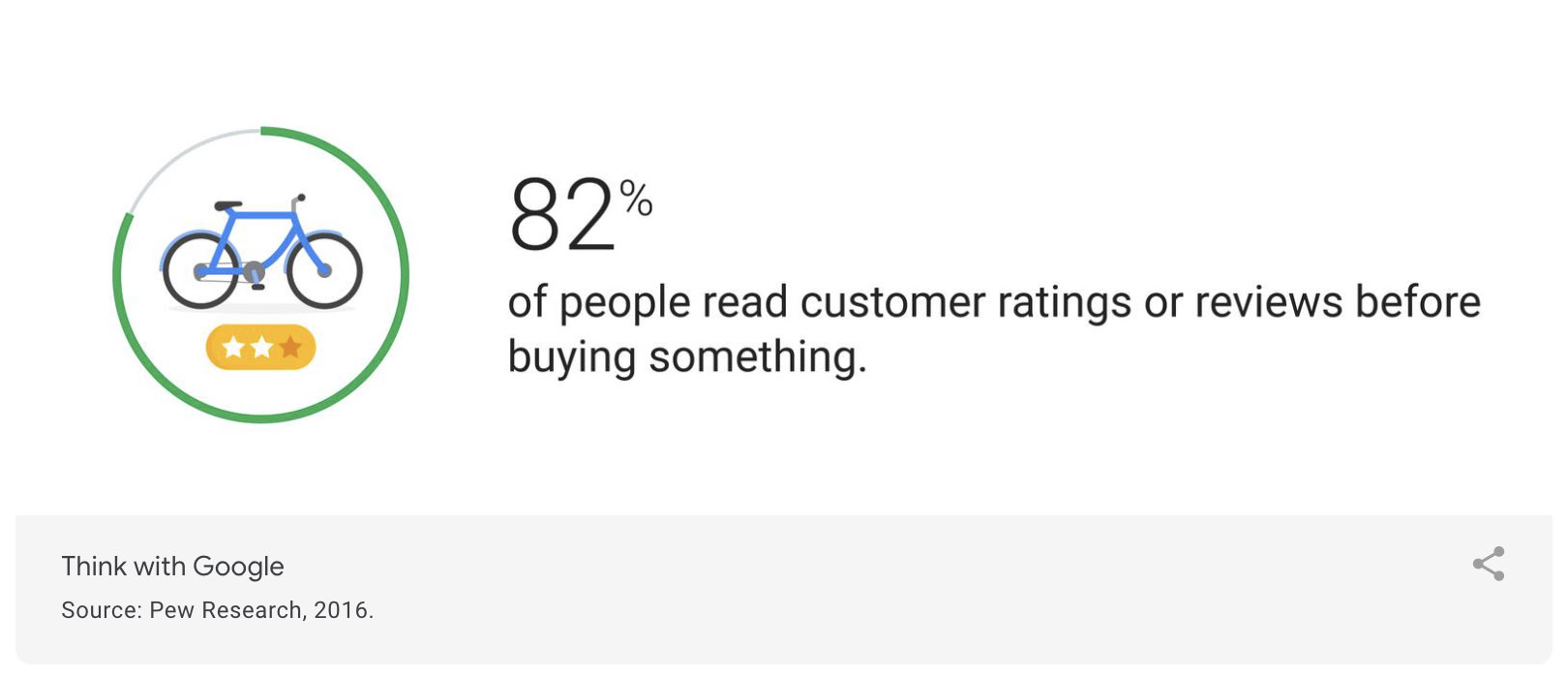
According to ThinkwithGoogle, 82% of people read customer ratings or reviews of products and services before buying them. Usually, it’s not enough to persuade customers, because in most cases, the major goal of reading reviews is to find drawbacks.
More than 55% of people claim they google a product and then visit YouTube to get more information about it before making a purchase. Interestingly, people entertain themselves by watching review videos about businesses that are made by third parties.
Considering the massive popularity of video content these days and the number of available video platforms, encouraging users to leave reviews is a great way to get more people to discover your e-commerce business.
Create E-commerce Video Ads in Seconds with Softcube AI
If you’re planning to promote your e-commerce business with high-quality video advertising, test the Softcube artificial intelligence platform. It optimizes the video production process in three steps:
- First, it crawls your product or catalog pages to get important content for creating your video ads such as your logo, brand colors, and text.
- Then it finds the most suitable footage from a product video library of more than 2 million clips.
- Finally, it compiles a video ad with content from your product or catalog page based on a product-specific template.
Not to mention that you can diversify your video ads with sounds, shapes, motions, and transitions. Here’s a simple example of a video ad made by our e-commerce marketing company:
Create your e-commerce video ad right now in less time than it took you to read this article.
Thank you for reading, and happy selling!
